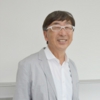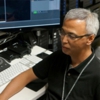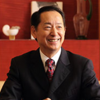
Below are comments from the juries who judged the five finalists in the Main Contest.
Juries for the Main Contest

Toyo Ito
(Architect)
Since it is spherical, the Geo-Cosmos allows viewers to move while watching it. The projection on the Geo-Cosmos is moving, too. In a sense that it allows viewers to watch moving images from any direction, this “mobility” is what the Geo-Cosmos is all about. I think the key point of this contest was whether the creator could successfully develop new expressions utilizing such mobility.
I felt the power of the finalists' works and I enjoyed them very much as a jury.

Toshiyuki Inoko
(CEO, teamLab Inc.)
I liked the works that had messages for everyone, like “it is humans that shape and foster the Earth.” I was very happy to see so many kinds of glowing globes.

Ingo Günther
(Artist)
My only regret is that we could only judge the 5 finalists tonight and not all the 67 contestants and their artistic work. It was not easy to select the works that would be successful in this ambitious ambiguity that was required. But I hope that we, as 8 male jury members judging 5 ladies’ works, were nevertheless just and inspiring.

Jeff Mills
(DJ/Techno Producer)
This jury selection was never easy because you have to kind of dissect someone’s creativity along with meaning. I think the Geo-Cosmos is probably one of the most important things that we have in order to look at ourselves and monitor how our planet is doing. So I hope that more things are going to happen to the Geo-Cosmos.

Hideki Shirakawa
(Nobel Prize in Chemistry, chemist)
I hesitated a lot when Dr. Mohri invited me to be a jury for the contest because I had no confidence in judging artistic quality and appeal, although I have been a jury for scientific papers and contests quite a few times. However, I decided to take this opportunity when I heard that there would be juries from various fields and I thought maybe I could enjoy the differences between how they look at the works.
As I expected, views were very different from person to person. Juries’ evaluations for the five finalists varied a lot, especially mine. However, anyway, expressions on the spherical surface of the Geo-Cosmos belong to a totally different category from the traditional two-dimensional paintings or steric installations. I respect the efforts and creativity of the five finalists who took this challenge and passed through to the Main Contest.
Frankly speaking, I was very impressed by how differently people look at the same works.

Yoshikatsu Date
(Exective Producer, NHK Enterprises, Inc.)
I imagine that applicants found both joy and difficulty in pursuing expressions on the Geo-Cosmos, which is somewhat a unique device with a spherical surface. There is no other device like the Geo-Cosmos and this means that a creator has a chance to open up a new horizon. The staff members at Miraikan are very ambitious. I hope they continue to create more contents for the Geo-Cosmos.

Koichiro Tsujikawa
(Graphic designer/video artist)
Indeed, the juries’ opinions varied a lot. But I think this is because each work had its own power. The Geo-Cosmos is a unique, spherical, and huge display. For me, it was a very exciting experience to see the works on this display.

Tota Hasegawa
(Creative Executive Director, Wieden+Kennedy Tokyo)
The Geo-Cosmos is already something to see when it displays the earth. I imagine it is demanding work to conceive of video that is superior. I had a great time watching the various works. I also felt that the presence of the video projected on the Geo-Cosmos was huge.
Comment on the contest from the chief jury, Mamoru Mohri

Mamoru Mohri
(Chief Executive Director, Miraikan)
The Earth that I saw from space in 1992 was a blue, glowing sphere floating in the middle of pitch-darkness. There was no sense of borders, nor top or bottom. Since the opening of Miraikan in 2001, we have been sharing that look of the Earth with the visitors through our symbolic exhibition, which uses blue light-emitting diodes invented by a Japanese researcher who recently won the Nobel Prize in physics. Thanks to the development in research on displays, the exhibition saw a renewal in 2011 and came back as a super high-resolution display, the Geo-Cosmos, which features environmentally-friendly organic EL panels. It was almost exactly the same as the blue, glowing sphere that I saw from space and it also contained great possibilities for new expressions as a spherical display. Celebrating its 10th anniversary, Miraikan started a new project called “Tsunagari” that year.
The “Tsunagari” Project is intended to offer hints for solutions to the global issues we are facing, by collecting scientific information about the Earth from domestic and international research institutions, translating them into new expressions that appeal to human senses, and sharing them with many people. The Geo-Cosmos, our symbolic exhibition, is the core of such attempts.
The Contest was not just limited to the visualization of scientific data but it was also open to other various contents. It is a great pleasure that this first contest saw so many art works made with different senses and had such impressive award-winning works.
We are now facing various global issues, such as climate change, energy, biodiversity and food security. Miraikan will continue to offer opportunities for everyone to think about the connections between people and the Earth, between living things, and between now and the future. I am looking forward to seeing new expressions and various connections growing between people through the contest from the next year on, too.


